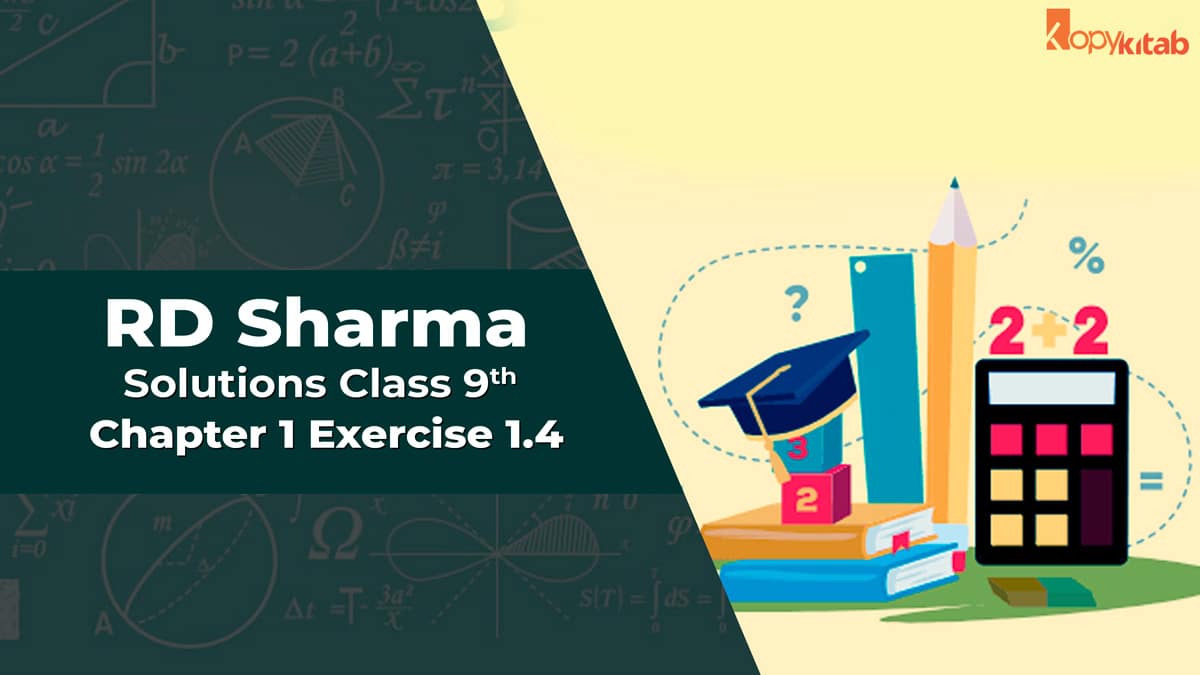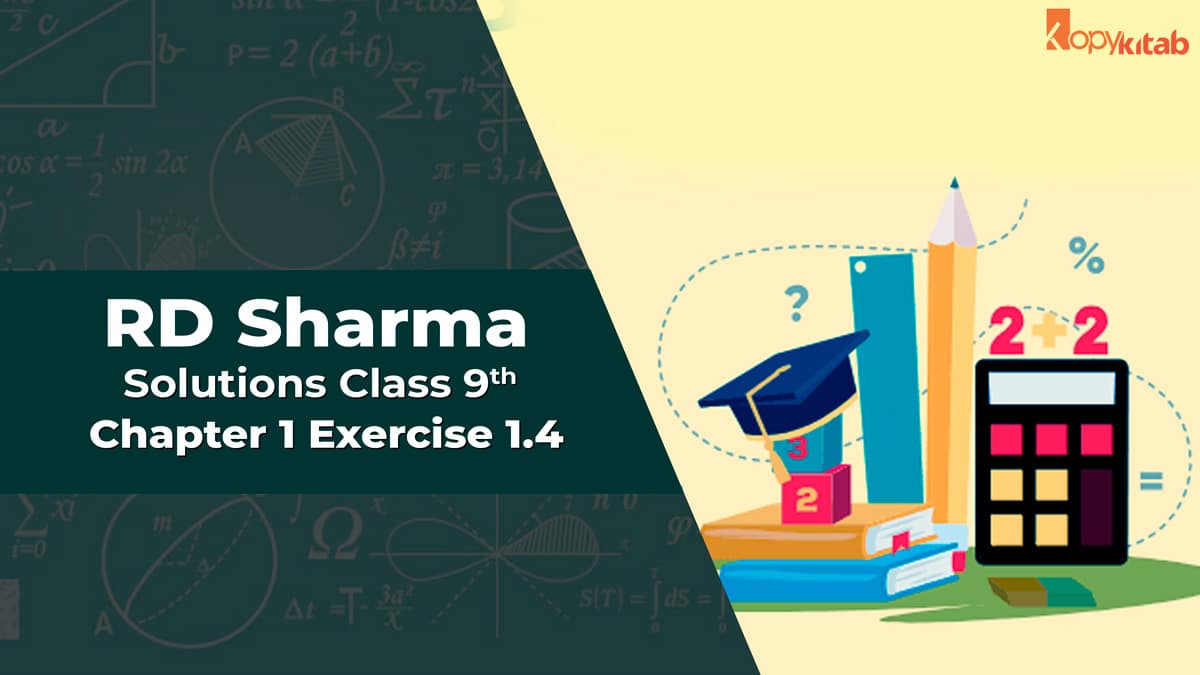
RD Sharma Class 9 Solutions Chapter 1 Exercise 1.4: When it comes to finding a good help book one should always go for RD Sharma Solutions Class 9 Maths. It is because of many reasons like reliable and easy-to-understand solutions, solutions as per the current CBSE Syllabus, and more. To know more about the RD Sharma Class 9 Solutions Chapter 1 Exercise 1.4, you must go through the whole blog.
Download RD Sharma Class 9 Solutions Chapter 1 Exercise 1.4
RD Sharma Class 9 Solutions Chapter 1 Exercise 1.4
Access answers of RD Sharma Class 9 Solutions Chapter 1 Exercise 1.4
RD Sharma Solutions Class 9 Chapter 1 Number System Ex 1.4
Question 1: Define an irrational number.
Solution:
A number that cannot be expressed in the form of p/q, where p and q are integers and q ≠ 0. It is a non-terminating or non-repeating decimal.
Question 2: Explain how irrational numbers differ from rational numbers.
Solution:
An irrational number is a real number that can be written as a decimal but not as a fraction i.e. it cannot be expressed as a ratio of integers.
It cannot be expressed as a terminating or repeating decimal.
For example, √2 is an irrational number
A rational number is a real number that can be written as a fraction and as a decimal, i.e. it can be expressed as a ratio of integers.
It can be expressed as a terminating or repeating decimal.
For example, 0.10 and 5/3 are rational numbers
Question 3: Examine whether the following numbers are rational or irrational:
Solution:
(i) √7
Not a perfect square root, so it is an irrational number.
(ii) √4
A perfect square root of 2.
We can express 2 in the form of 2/1, so it is a rational number.
(iii) 2 + √3
Here, 2 is a rational number, but √3 is an irrational number
Therefore, the sum of a rational and irrational number is an irrational number.
(iv) √3 + √2
√3 is not a perfect square, thus an irrational number.
√2 is not a perfect square, thus an irrational number.
Therefore, the sum of √2 and √3 gives an irrational number.
(v) √3 + √5
√3 is not a perfect square, and hence, it is an irrational number
Similarly, √5 is not a perfect square, and it is an irrational number.
Since the sum of two irrational numbers is an irrational number, √3 + √5 is an irrational number.
(vi) (√2 – 2)2
(√2 – 2)2 = 2 + 4 – 4 √2
= 6 – 4 √2
Here, 6 is a rational number, but 4√2 is an irrational number.
Since the sum of a rational and an irrational number is an irrational number, (√2 – 2)2 is an irrational number.
(vii) (2 – √2)(2 + √2)
We can write the given expression as;
(2 – √2)(2 + √2) = ((2)2 − (√2)2)
[Since, (a + b)(a – b) = a2 – b2]
= 4 – 2 = 2 or 2/1
Since 2 is a rational number, (2 – √2)(2 + √2) is a rational number.
(viii) (√3 + √2)2
We can write the given expression as;
(√3 + √2)2 = (√3)2 + (√2)2 + 2√3 x √2
= 3 + 2 + 2√6
= 5 + 2√6
[using identity, (a+b)2 = a2 + 2ab + b2]
Since the sum of a rational number and an irrational number is an irrational number, (√3 + √2)2 is an irrational number.
(ix) √5 – 2
√5 is an irrational number, whereas 2 is a rational number.
The difference between an irrational number and a rational number is an irrational number.
Therefore, √5 – 2 is an irrational number.
(x) √23
Since, √23 = 4.795831352331…
As the decimal expansion of this number is non-terminating and non-recurring, it is an irrational number.
(xi) √225
√225 = 15 or 15/1
√225 is a rational number as it can be represented in the form of p/q, and q is not equal to zero.
(xii) 0.3796
As the decimal expansion of the given number is terminating, it is a rational number.
(xiii) 7.478478……
As the decimal expansion of this number is a non-terminating recurring decimal, it is a rational number.
(xiv) 1.101001000100001……
As the decimal expansion of the given number is non-terminating and non-recurring, it is an irrational number
Question 4: Identify the following as rational or irrational numbers. Give the decimal representation of rational numbers:
Solution:
(i) √4
√4 = 2, which can be written in the form of a/b. Therefore, it is a rational number.
Its decimal representation is 2.0.
(ii) 3√18
3√18 = 9√2
Since the product of a rational and an irrational number is an irrational number, 3√18 is an irrational number.
Or 3 × √18 is an irrational number.
(iii) √1.44
√1.44 = 1.2
Since every terminating decimal is a rational number, √1.44 is a rational number.
And its decimal representation is 1.2.
(iv) √9/27
√9/27 = 1/√3
Since the quotient of a rational and an irrational number is irrational numbers, √9/27 is an irrational number.
(v) – √64
– √64 = – 8 or – 8/1
Therefore, – √64 is a rational number.
Its decimal representation is –8.0.
(vi) √100
√100 = 10
Since 10 can be expressed in the form of a/b, such as 10/1, √100 is a rational number.
And its decimal representation is 10.0.
Question 5: In the following equation, find which variables x, y, z etc. represent rational or irrational numbers:
Solution:
(i) x2 = 5
Taking square root on both sides,
x = √5
√5 is not a perfect square root, so it is an irrational number.
(ii) y2 = 9
y2 = 9
or y = 3
3 can be expressed in the form of a/b, such as 3/1, so it is a rational number.
(iii) z2 = 0.04
z2 = 0.04
Taking square root on both sides, we get
z = 0.2
0.2 can be expressed in the form of a/b, such as 2/10, so it is a rational number.
(iv) u2 = 17/4
Taking square root on both sides, we get
u = √17/2
Since the quotient of an irrational and a rational number is irrational, u is an Irrational number.
(v) v2 = 3
Taking square root on both sides, we get
v = √3
Since √3 is not a perfect square root, v is an irrational number.
(vi) w2 = 27
Taking square root on both sides, we get
w = 3√3
Since the product of a rational and irrational is an irrational number, w is an irrational number.
(vii) t2 = 0.4
Taking square root on both sides, we get
t = √(4/10)
t = 2/√10
Since the quotient of a rational and an irrational number is an irrational number t is an irrational number.
This is the complete blog of RD Sharma Class 9 Solutions Chapter 1 Exercise 1.4. To know more about the CBSE Class 9 Maths exams, ask in the comments.
FAQs on RD Sharma Class 9 Solutions Chapter 1 Exercise 1.4
How much does it cost to download the PDF of RD Sharma Class 9 Solutions Chapter 1 Exercise 1.4?
You can download it for free.
Can I access the RD Sharma Solutions Class 9 Maths Chapter 1 Exercise 1.4 PDF offline?
Once you have downloaded the PDF online, you can access it offline as well.
Are the solutions RD Sharma Solutions Class 9 Maths Chapter 1 Exercise 1.4 relevant?
The solutions are relevant as they are designed by the subject matter experts.



